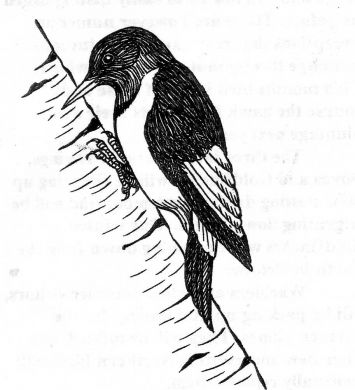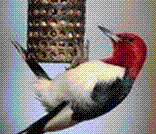Blog - General
Red-headed Woodpecker

The Red-headed Woodpecker is one of the most striking birds of the woodpecker family. They sport a bright crimson head with feathers so fine it has the appearance of velour. The back is black with the upper wing and balance pure white. Juvenile birds however are difficult to identify. The head and upper back are often a dark brown, making identification somewhat tricky at times. It is one of the more aggressive members of the woodpecker family, thus if they are attracted to your feeders they may appear to be a bit aggressive to other woodpeckers.
The populations of this beautiful bird have been in an alarming decline. Enough so they have been listed by Audubon as a species of concern. There may be several reasons. The most common is the same problem all cavity nesting birds face, loss of habitat. Woodpeckers are primary cavity nesting birds, excavating a new nest site each year. The removal of trees, especially dead trees, for fire wood, development, and other human activities has had a profound impact on many of these birds.
Another threat is the European Starling. Starlings will gang up on a nesting pair of woodpeckers, attempting to kill them and drive them off. It is estimated that Red-bellied Woodpeckers alone lose half their nests to Starlings. Once the Starlings have succeeded in confiscating the nest cavity, a squabble ensues as to which pair will take it over. It usually goes to the most dominant pair. Finally, the Red-headed Woodpeckers reckless desire to feed on easily accessible worms and caterpillars crawling across highways and roads often lands a fatal blow. No other bird seems to be so oblivious to a speeding automobile than the Red-headed Woodpecker. Great numbers are killed each year by cars.
The movement of this bird during the winter months depends on the supply of acorns. Northern birds may migrate to the southern parts of their range, with most having left for winter quarters by late October. In the south these birds are often permanent residents. They prefer to winter over in forests and woodlands where oak trees are present. During lean years it may be hard to find even a few of them.
 Red-headed Woodpeckers are the most omnivorous of the woodpeckers. Besides acorns they will readily feed on corn, sunflower seed, peanuts, fruits and berries. Two thirds of their diet is made up of plant matter. They also feed on a variety of insects, larvae, and other opportune protein sources such as suets. Along with their cousin, the Lewis’s Woodpecker found in western regions, they will hawk insects out of the air in flight.
Red-headed Woodpeckers are the most omnivorous of the woodpeckers. Besides acorns they will readily feed on corn, sunflower seed, peanuts, fruits and berries. Two thirds of their diet is made up of plant matter. They also feed on a variety of insects, larvae, and other opportune protein sources such as suets. Along with their cousin, the Lewis’s Woodpecker found in western regions, they will hawk insects out of the air in flight.
Wingtip: Woodpeckers will stiffen their tail to provide leverage when drilling holes, drumming, and feeding.
The Red-headed Woodpecker’s breeding habitat is open country across southern Canada the eastern United States and Central Great Plains. They arrived on the breeding range by late April, with nesting activities starting in May. As with all woodpeckers, they prefer to excavate their nest in a dead tree or dead branch on a tree. These are referred to as snags. Unlike some of the other woodpeckers, the Red-headed prefers this over a man-made nesting box. Once the nest hole has been completed, the female will lay a clutch of about 5 white eggs in the nest, which is located from eight feet to eighty feet above the ground. The male will share in the duties of incubation which lasts about two weeks. Once the young have hatched, both the male and female will assume the responsibilities of feeding until they fledge which can take up to four weeks. If a second clutch of eggs is produced the adults may drive the older siblings off in order to raise the new family.
The future of the Red-headed Woodpecker remains uncertain. In Canada they are listed as a vulnerable species. In the United States they are listed as near threatened. The species has declined in numbers due to habitat loss caused by harvesting of snags, agricultural development, channeling of rivers, a decline in farming resulting to regeneration of eastern forests, monoculture crops, the loss of small orchards, and treatment of telephone poles with creosote.
Wingtip: Woodpeckers, as with other cavity nesting birds, will use old nest cavities and nest boxes as a winter roost to retreat from harsh weather.
Red-headed Woodpecker Fun Facts
• The Red-headed Woodpecker is one of only four woodpeckers known to store food. They will cache away nuts and seed. They are the only woodpecker known to cover their cache to hide it from view of others. They will also hide insects in cracks of tree bark, in wooden fence posts, even under shingles on roofs. They will regularly hide live grasshoppers, wedging them into crevices so tight they cannot escape.
• Red-headed Woodpeckers will attack and drive other birds out of their territory. They will go as far as to remove the eggs from the nests of other bird species, destroying nests, or puncturing eggs.
• The Red-headed Woodpecker benefits from diseases that attack trees. One such disease, Dutch Elm, killed many trees providing abundant nesting sites.
Wingtip: Secondary cavity nesting birds, Chickadees, Bluebirds, Wrens, Screech Owls, Nuthatches, to name a few, rely on old woodpecker holes to build their nests. These birds also become susceptible to parasitism by the European Starling. Further, the lack of snags that provide woodpecker nest sites impact secondary cavity nesting birds.

It is a shame indeed, to see this bird drift into extinction, because of an invasive species which we introduced into it’s environment…the European Starling. I documented this from 2006-2016 in NW Tenn. The Red-Headed Woodpecker was a “Spark Bird” for me at age 5. Dan